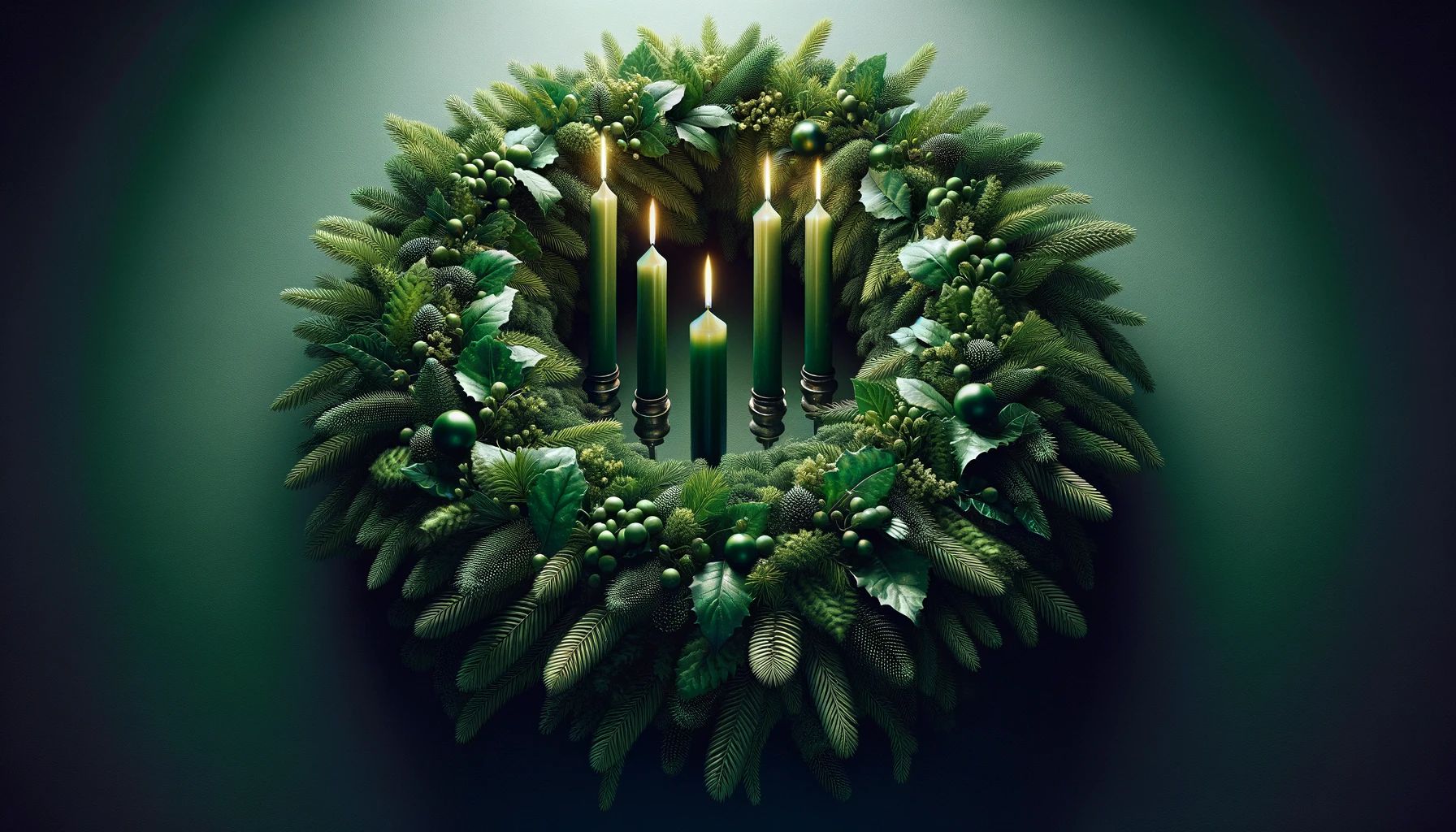Home>Special Themes>How Did The Advent Wreath Start


Special Themes
How Did The Advent Wreath Start
Published: February 12, 2024
Ericka Andersen, an editor at Christian.net, expertly merges digital strategy with content creation, focusing on faith and societal issues. Her communication skills enhance the platform's engaging narratives, fostering meaningful dialogue on belief's impact on society.
Discover the origins of the Advent wreath and its significance in the Christian tradition. Learn about its special themes and the history behind its creation.
(Many of the links in this article redirect to a specific reviewed product. Your purchase of these products through affiliate links helps to generate commission for Christian.net, at no extra cost. Learn more)
Table of Contents
Introduction
The Advent wreath is a cherished symbol of the holiday season, evoking a sense of anticipation and hope as it graces homes, churches, and communal spaces. This timeless tradition has deep roots in history and carries profound symbolism that resonates with people around the world. As we delve into the origins, symbolism, and modern-day significance of the Advent wreath, we will uncover the rich tapestry of traditions and beliefs that have shaped this beloved custom.
The Advent wreath, with its vibrant evergreen foliage and flickering candles, serves as a poignant reminder of the spiritual journey towards Christmas. Its presence heralds the beginning of the Advent season, a period of preparation and reflection leading up to the joyous celebration of Christ's birth. With each candle representing a different aspect of the Advent story, the wreath becomes a visual and symbolic focal point, guiding individuals and communities through the spiritual significance of the season.
As we explore the history and evolution of the Advent wreath, we will gain a deeper appreciation for the enduring traditions that have been passed down through generations. From its humble beginnings to its widespread adoption across various cultures, the Advent wreath has woven itself into the fabric of holiday traditions, offering a timeless connection to the past while kindling a sense of unity and shared purpose in the present.
In the following sections, we will embark on a captivating journey through time, unraveling the origins, symbolism, and evolution of the Advent wreath tradition. By understanding the profound significance of this cherished symbol, we can embrace the spirit of anticipation and renewal that it embodies, enriching our holiday experience and fostering a deeper sense of connection with the traditions that have stood the test of time.
Read more: How To Draw An Advent Wreath
Origins of the Advent Wreath
The origins of the Advent wreath can be traced back to pre-Christian Germanic and Scandinavian cultures, where the use of evergreen wreaths during the dark winter months symbolized life, hope, and the enduring cycle of nature. These early wreaths, often adorned with candles, served as potent symbols of light and warmth amidst the cold and darkness, embodying the resilience of life even in the harshest of seasons.
The specific adaptation of the Advent wreath as a Christian tradition is attributed to 19th-century German Lutherans, who crafted the first known Advent wreath by combining the symbolism of the pre-existing wreaths with the spiritual significance of the Advent season. This innovative fusion of cultural and religious elements gave rise to the iconic Advent wreath as we know it today.
The traditional Advent wreath consists of a circular evergreen wreath, symbolizing the eternal nature of God and the unending cycle of the seasons. Within this wreath are four candles, typically three purple and one pink, arranged symmetrically around the circumference. Each candle holds its own symbolic meaning, representing the four weeks of Advent and the themes of hope, love, joy, and peace, respectively.
The lighting of the candles, one for each week leading up to Christmas, serves as a ceremonial act of anticipation and spiritual preparation. As the weeks progress, the increasing illumination of the wreath mirrors the growing anticipation and the gradual emergence of hope and joy as Christmas draws near.
The Advent wreath, with its deep historical roots and profound symbolism, stands as a testament to the enduring power of tradition and the seamless integration of cultural practices into religious observance. Its evolution from ancient pagan customs to a cherished Christian symbol exemplifies the transformative nature of traditions, as they adapt and evolve while retaining their core significance.
In embracing the origins of the Advent wreath, we honor the interconnectedness of diverse cultural influences and the timeless resonance of symbols that transcend generations. This deep understanding enriches our experience of the Advent season, fostering a profound connection to the traditions that have shaped our collective heritage.
Symbolism of the Advent Wreath
The Advent wreath is steeped in profound symbolism, with each element carrying rich meaning that resonates deeply with the spiritual journey of the Advent season. At the heart of this cherished tradition lies a tapestry of symbols that illuminate the path towards Christmas, inviting individuals and communities to embrace the timeless themes of hope, love, joy, and peace.
The circular shape of the Advent wreath represents the eternal nature of God and the unending cycle of the seasons. This enduring form serves as a powerful reminder of the everlasting presence of divine love and the continuous renewal of faith and hope. As the wreath encircles the candles, it symbolizes the encompassing embrace of God's grace and the unbroken connection between past, present, and future.
The evergreen foliage adorning the Advent wreath holds profound significance, representing life, resilience, and the enduring nature of faith. In the midst of winter's dormancy, the vibrant greenery serves as a symbol of hope and renewal, reminding us of the eternal vitality of the spirit and the promise of new beginnings. The evergreen branches, with their unwavering verdant hue, embody the timeless truths of faith that remain steadfast and unchanging amidst the passage of time.
The candles nestled within the Advent wreath are emblematic of the gradual illumination of the world with the light of Christ. The first candle, often purple, symbolizes hope and serves as a beacon of anticipation, heralding the advent of a new dawn. The subsequent candles, also purple, represent love and peace, infusing the atmosphere with their gentle radiance. The pink candle, lit on the third Sunday of Advent, symbolizes joy, casting a warm and jubilant glow as the anticipation of Christmas intensifies.
As each candle is lit in succession, the increasing light signifies the progressive revelation of spiritual truths and the deepening of faith. The illumination of the Advent wreath mirrors the growing anticipation and the gradual emergence of hope, love, joy, and peace as Christmas draws near, inviting individuals to embark on a transformative journey of spiritual preparation and contemplation.
In essence, the Advent wreath serves as a visual and symbolic guide, leading us through the profound themes of the Advent season and illuminating the path towards the celebration of Christ's birth. Its timeless symbolism resonates with the universal human experience, offering a poignant reminder of the enduring presence of hope, love, joy, and peace in our lives, and inspiring a deeper connection to the spiritual essence of the holiday season.
Evolution of the Advent Wreath Tradition
The evolution of the Advent wreath tradition is a testament to the enduring adaptability and resonance of this cherished symbol across diverse cultures and historical periods. From its humble origins to its widespread adoption in contemporary religious observance, the Advent wreath has traversed a remarkable journey, embodying the seamless integration of tradition, spirituality, and cultural heritage.
The early Christian adaptation of the Advent wreath, attributed to 19th-century German Lutherans, marked a pivotal moment in the evolution of this tradition. By incorporating the symbolism of pre-existing evergreen wreaths with the spiritual significance of the Advent season, a new and profound tradition was born. This innovative fusion not only honored the cultural practices of the past but also imbued them with deeper spiritual meaning, creating a bridge between ancient customs and Christian observance.
As the tradition of the Advent wreath spread beyond its Germanic origins, it found resonance in diverse Christian denominations and communities worldwide. Each cultural context infused the tradition with unique nuances, enriching the symbolism and practices associated with the Advent wreath. From variations in candle colors to the inclusion of additional elements such as ribbons, fruits, or symbolic ornaments, the evolution of the Advent wreath tradition reflects the dynamic interplay between tradition and cultural expression.
In the modern era, the Advent wreath has transcended its religious significance to become a cherished symbol in secular holiday celebrations. Its timeless themes of hope, love, joy, and peace resonate with people of diverse backgrounds, fostering a sense of unity and shared purpose during the holiday season. The widespread presence of Advent wreaths in homes, churches, and public spaces serves as a unifying thread, weaving together individuals and communities in a collective embrace of the holiday spirit.
The evolution of the Advent wreath tradition exemplifies the enduring power of symbols to transcend time and cultural boundaries, offering a timeless connection to the spiritual essence of the holiday season. As the tradition continues to evolve and adapt, it remains a poignant reminder of the universal themes of hope, love, joy, and peace that unite humanity in the shared experience of anticipation and renewal.
In essence, the evolution of the Advent wreath tradition reflects the seamless integration of cultural practices into religious observance, honoring the interconnectedness of diverse traditions while embracing the enduring significance of symbols that transcend generations.
Modern Day Use of the Advent Wreath
In modern times, the Advent wreath continues to hold a cherished place in both religious and secular contexts, serving as a timeless symbol of anticipation, unity, and spiritual preparation during the holiday season. Its presence in homes, churches, and communal spaces evokes a sense of tradition and contemplation, inviting individuals and communities to embark on a meaningful journey through the weeks leading up to Christmas.
In religious observance, the Advent wreath remains a focal point of the Advent season, guiding worshippers through a period of spiritual reflection and anticipation. Churches and religious institutions incorporate the lighting of the Advent candles into their worship services, with each candle representing a distinct theme of the season. As the candles are progressively lit during the four weeks of Advent, the illuminating wreath becomes a visual representation of the growing anticipation and the deepening spiritual significance of the approaching Christmas celebration.
Beyond its religious symbolism, the Advent wreath has found resonance in secular holiday traditions, enriching the festive ambiance with its timeless themes of hope, love, joy, and peace. Many families and individuals incorporate the Advent wreath into their holiday decor, using it as a centerpiece for gatherings and a focal point for quiet moments of reflection. The act of lighting the Advent candles each week becomes a cherished ritual, fostering a sense of connection to the deeper spiritual essence of the season.
In contemporary society, the Advent wreath has also become a symbol of community and shared purpose, transcending religious boundaries to unite people in the universal experience of anticipation and renewal. Its presence in public spaces, such as town squares, shopping centers, and communal gatherings, serves as a unifying emblem, fostering a sense of collective celebration and reflection during the holiday season.
The enduring relevance of the Advent wreath in modern-day usage underscores its profound impact as a symbol of unity, hope, and spiritual contemplation. Whether in religious ceremonies, family homes, or communal settings, the Advent wreath continues to enrich the holiday experience, inviting individuals to embrace the timeless themes it embodies and fostering a deeper connection to the traditions that have stood the test of time.
In essence, the modern-day use of the Advent wreath reflects its enduring significance as a symbol of spiritual preparation, unity, and anticipation, enriching the holiday season with its timeless resonance and profound symbolism.
Conclusion
In conclusion, the Advent wreath stands as a timeless symbol of anticipation, unity, and spiritual preparation, weaving together the rich tapestry of traditions, symbolism, and cultural resonance. From its ancient origins in pre-Christian customs to its widespread adoption in contemporary religious and secular contexts, the Advent wreath embodies the enduring power of symbols to transcend time and cultural boundaries, fostering a sense of connection and contemplation during the holiday season.
The origins of the Advent wreath, rooted in the traditions of pre-Christian Germanic and Scandinavian cultures, reflect the enduring symbolism of evergreen foliage and candles as potent symbols of life, hope, and light amidst the darkness of winter. The adaptation of these symbols into a Christian tradition by 19th-century German Lutherans marked a transformative moment, giving rise to the iconic Advent wreath with its profound spiritual significance.
The symbolism of the Advent wreath, from its circular form representing the eternal nature of God to the evergreen foliage symbolizing resilience and the candles embodying the themes of hope, love, joy, and peace, resonates deeply with the spiritual journey of the Advent season. Each element serves as a poignant reminder of the enduring presence of faith, hope, and renewal, inviting individuals to embrace the timeless themes it embodies.
The evolution of the Advent wreath tradition reflects the seamless integration of cultural practices into religious observance, honoring the interconnectedness of diverse traditions while embracing the enduring significance of symbols that transcend generations. Its modern-day usage, both in religious ceremonies and secular holiday traditions, underscores its profound impact as a symbol of unity, hope, and spiritual contemplation, enriching the holiday experience with its timeless resonance and profound symbolism.
In essence, the Advent wreath serves as a visual and symbolic guide, leading individuals and communities through the profound themes of the Advent season and illuminating the path towards the celebration of Christ's birth. Its enduring relevance and universal resonance make it a cherished symbol that unites people in the shared experience of anticipation and renewal, fostering a deeper connection to the traditions that have stood the test of time.














